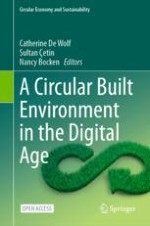13.1 Introduction
13.2 Digital Building Logbooks (DBLs)
13.2.1 DBLs in the European Built Environment
13.2.2 DBLs for a Circular Economy
13.2.3 Examples of DBLs in Europe
13.3 Data Fields Supporting Circular Strategies
Digital building logbook | |||||||
|---|---|---|---|---|---|---|---|
Category | Data field | Strategy | CLÉA | CHIMNI | WONINGPAS | CAPSA | CIRDAX |
Plot | Geolocation | ALL | × | × | × | × | |
Soil characterisation | Regenerate | × | |||||
Flood sensitivity | Regenerate | × | |||||
Water & sewage | Narrow/regenerate | × | |||||
Blue-green level | Regenerate | × | |||||
Solar potential | Narrow | × | |||||
Mobility | Narrow/regenerate | × | |||||
Building | Construction date | Slow | × | × | x | ||
Heritage listing | Slow | × | × | ||||
Building timeline | Slow | × | |||||
Home quality | Regenerate | × | |||||
Surface area | Slow | × | × | x | |||
Architectural characteristics | Slow/close | × | × | × | × | ||
Services | HVAC systems | Narrow | × | × | × | × | |
HVAC user guides | Slow | × | × | ||||
HVAC maintenance alerts | Slow | × | × | × | |||
Energy performance | Narrow | × | × | × | × | ||
Energy consumption | Narrow | × | x | × | |||
Energy monitoring | Narrow | × | × | ||||
Components and materials | Characterisation | Slow/close | × | × | |||
Embodied carbon | Narrow/close | × | × | ||||
Circular potential | Close | × | |||||
Marketplace | Close | × | |||||
Residual financial value | Close | × | |||||
Maintenance | Condition assessment | Slow | × | × | |||
Monitoring hotspots | Slow | × | |||||
Maintenance strategies | Slow | × | × | × | |||
Roadmaps | Energy renovation | Narrow | x | × | |||
Project templates | Slow | × | |||||
13.4 Business Models for DBLs
13.5 Discussion
13.5.1 Future Developments for DBLs
13.5.2 Market Uptake
13.5.3 DBLs as Enablers of Circular Economy
13.6 Key Takeaways
-
Digital building logbooks (DBLs) provide transparency and access to building-related data throughout the full life cycle of a building.
-
Reliable data can help improve the design, construction, and management of buildings, increase market transparency, create innovative services and business models, and lead to more effective policymaking.
-
DBLs have the potential to promote a circular economy by facilitating energy efficiency of buildings, lifespan extension, intelligent reuse, and tracking and tracing material resources for future use.
-
DBLs can contribute to creating a net positive impact if they include indicators related to biodiversity, surplus resources, and environmental quality at the building and neighbourhood level.
-
A life cycle thinking approach to DBLs can support decision-making based on resource optimisation and circularity principles.
-
Future developments should integrate renovation advice with material passports and marketplaces to balance achievements on operational and embodied carbon performance.
-
Despite the benefits of DBLs to support a circular built environment, a successful business model has not yet been proved on the market with fully defined unique selling propositions in a challenging context with high expectations, policy requirements, and a competitive environment with more and more DBL developers.
